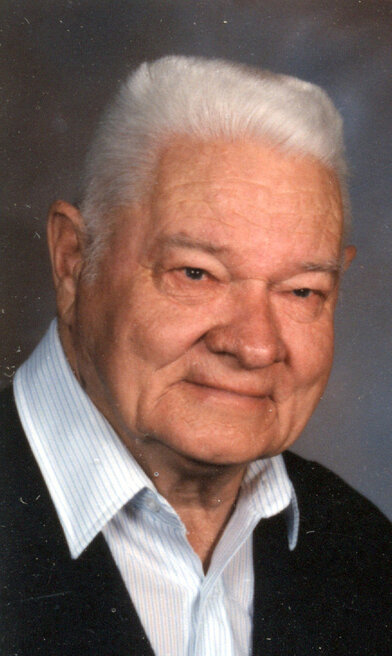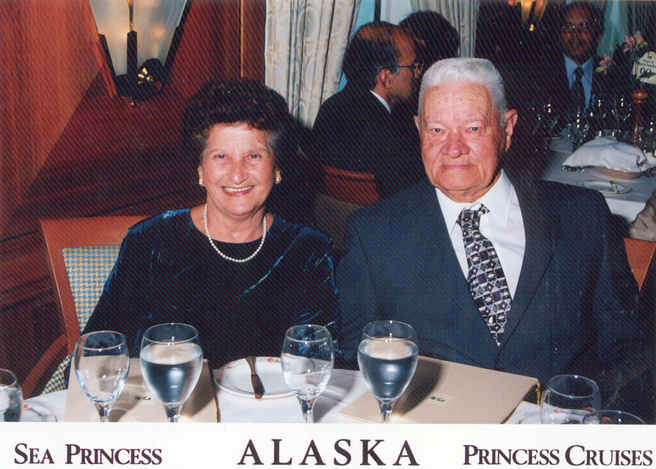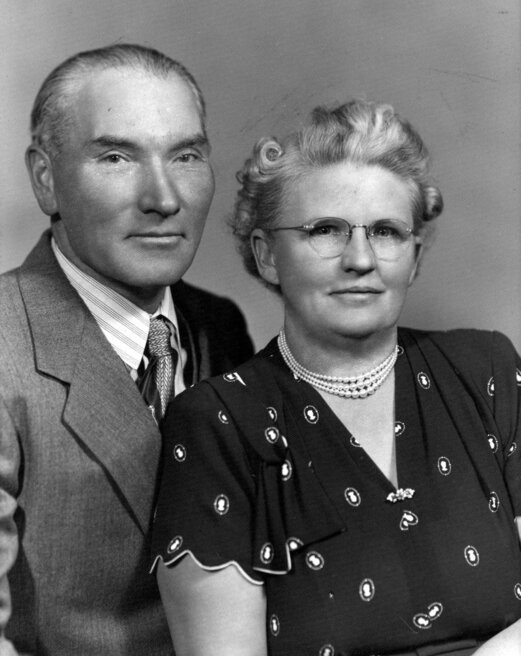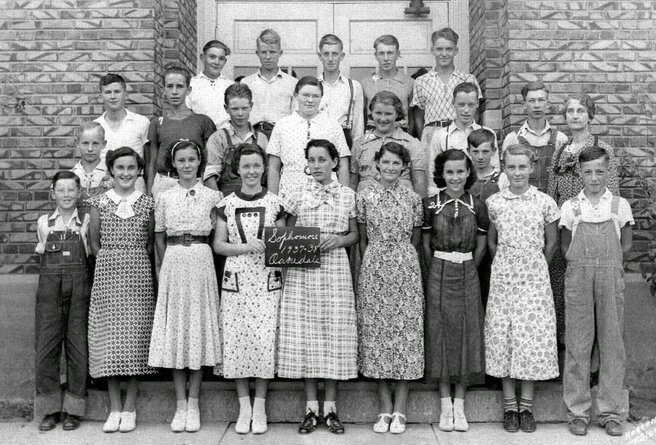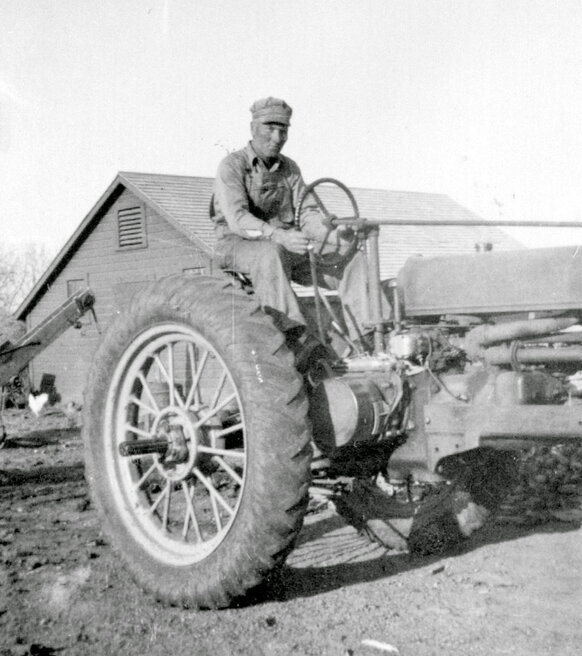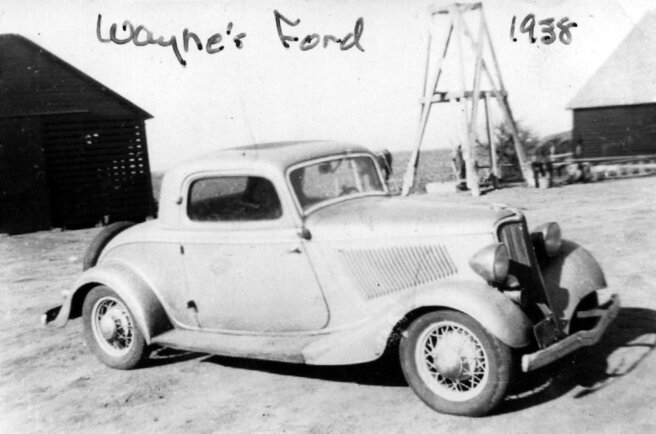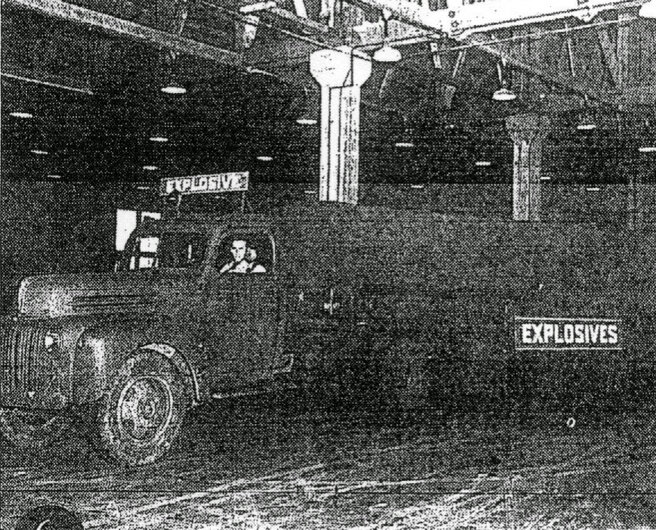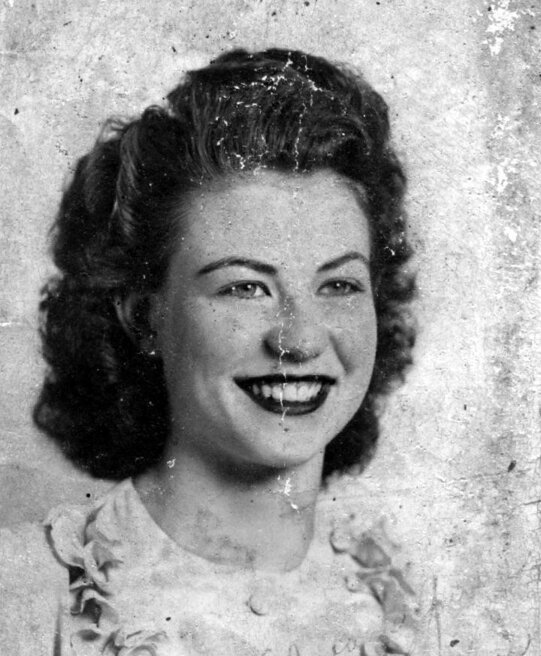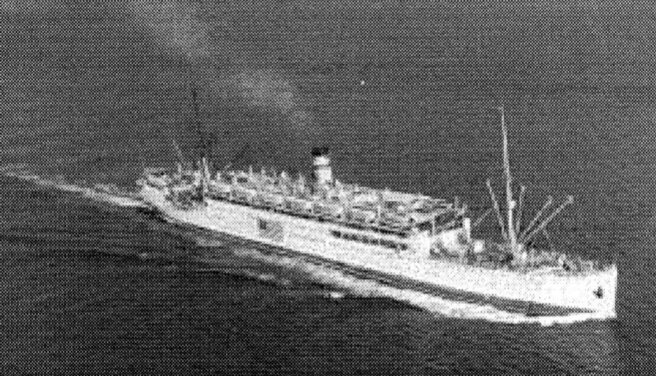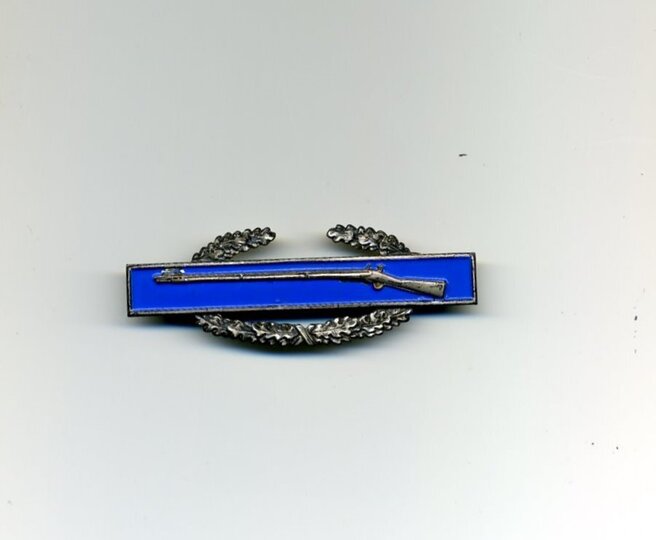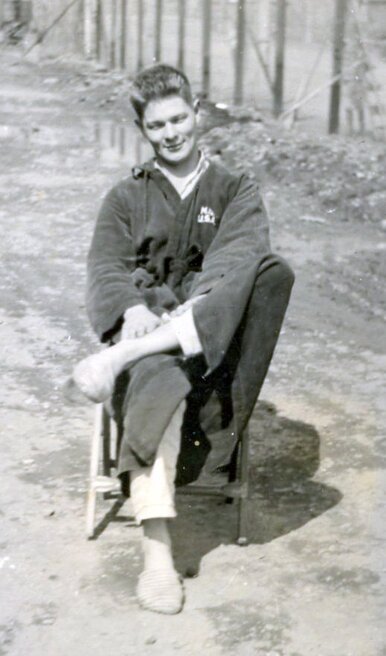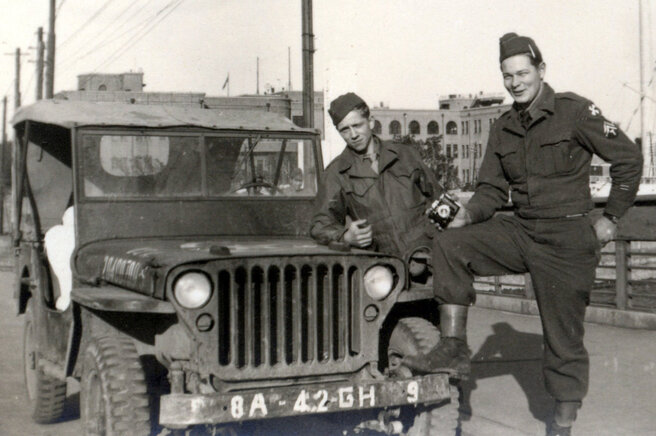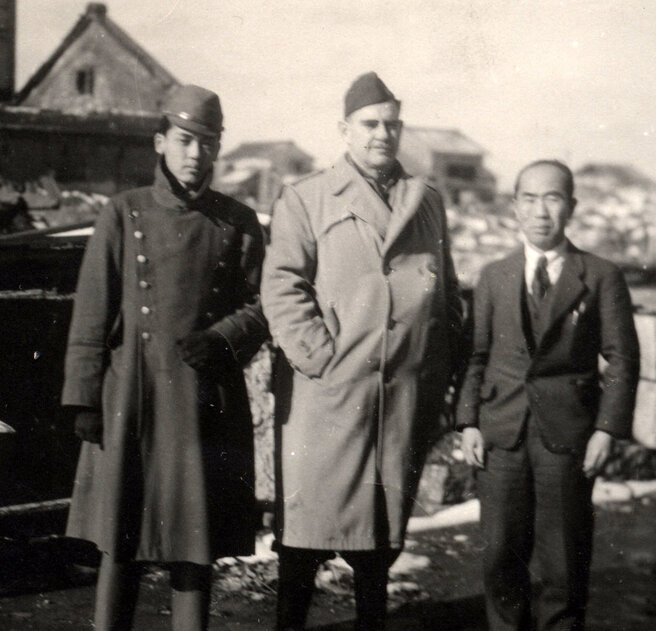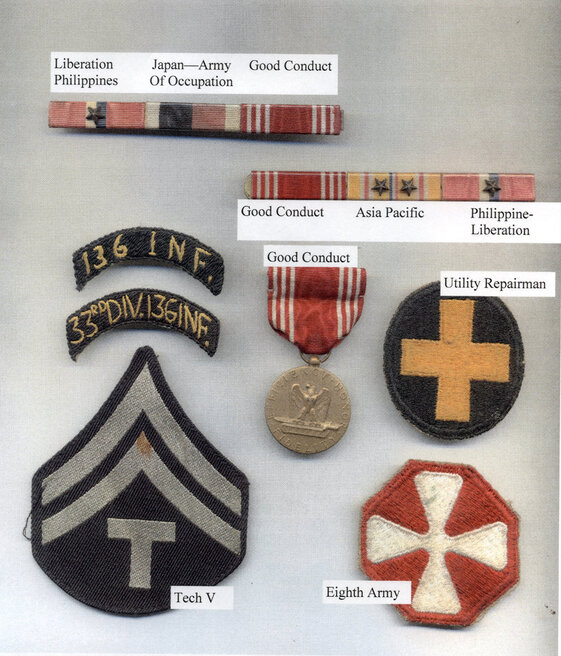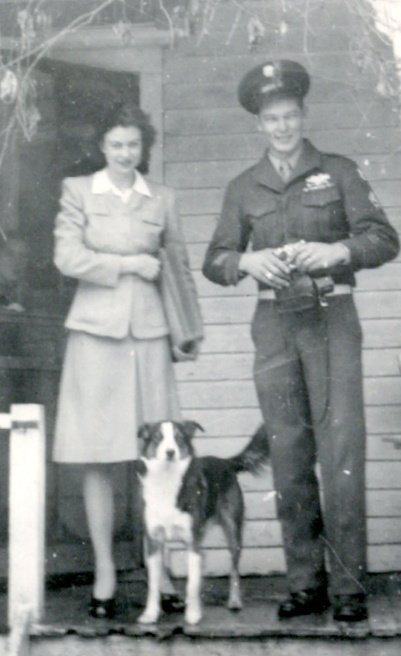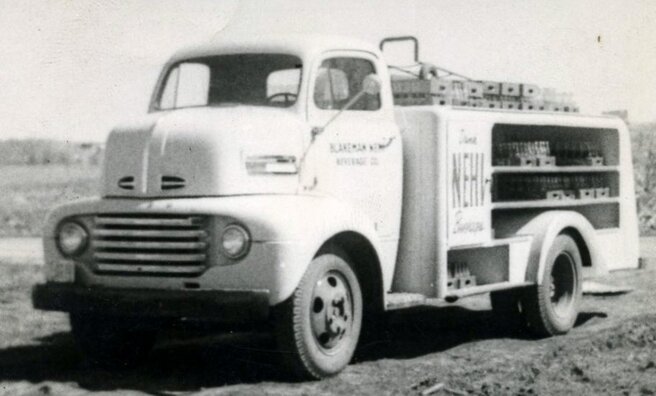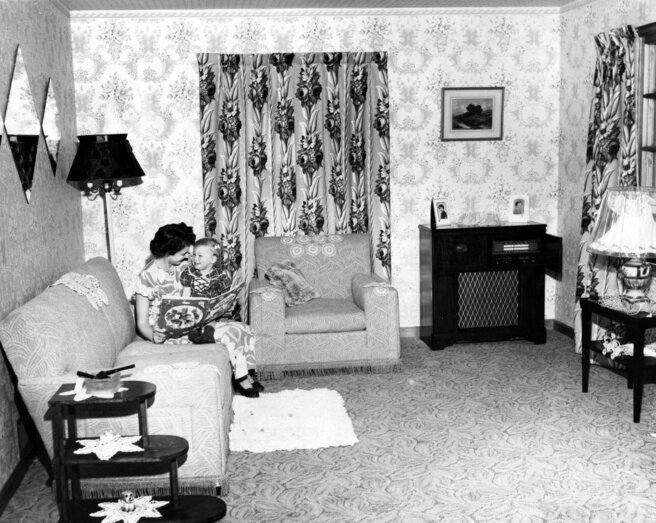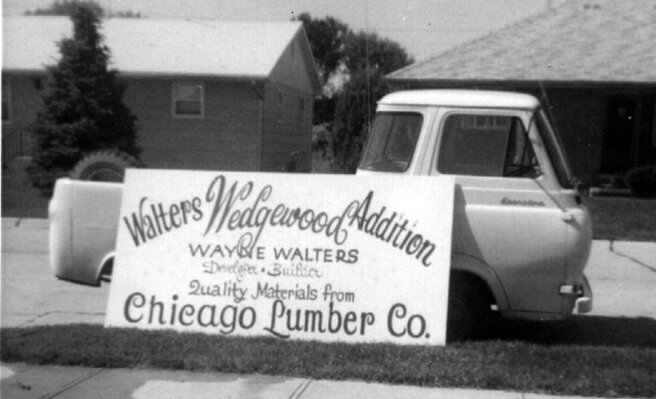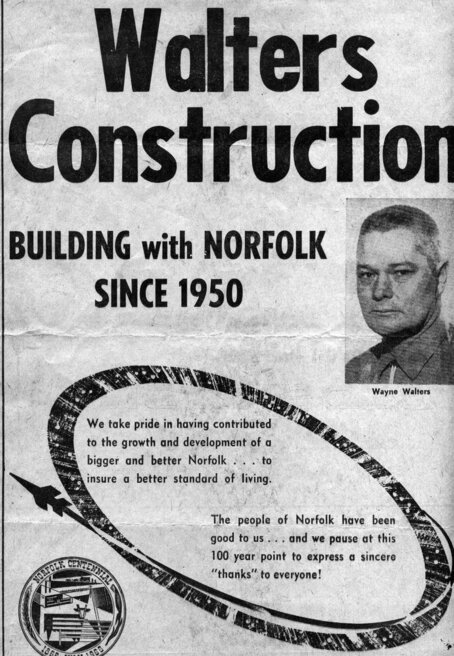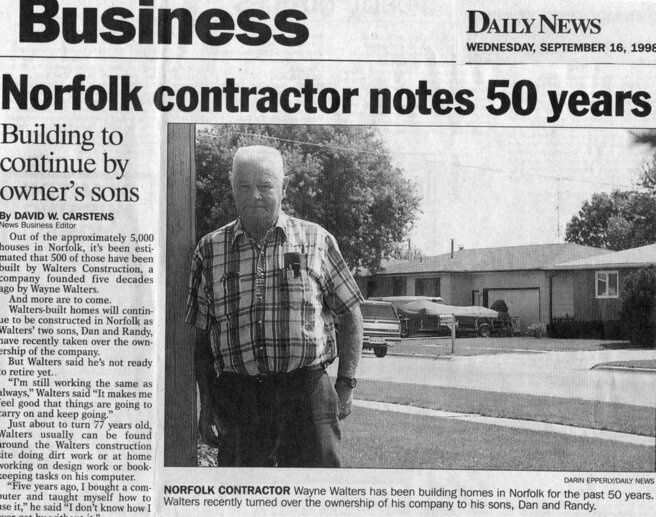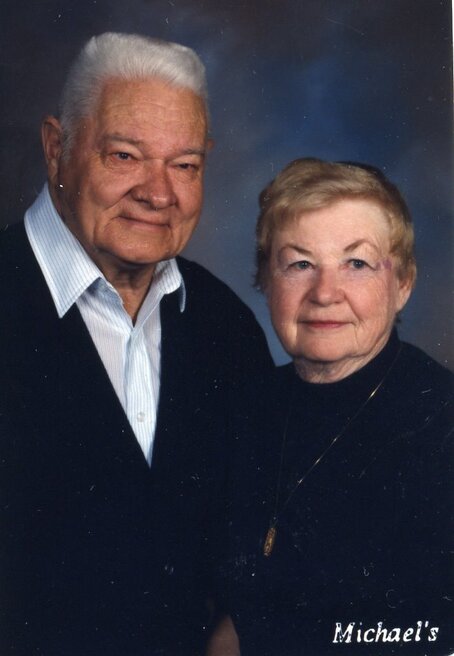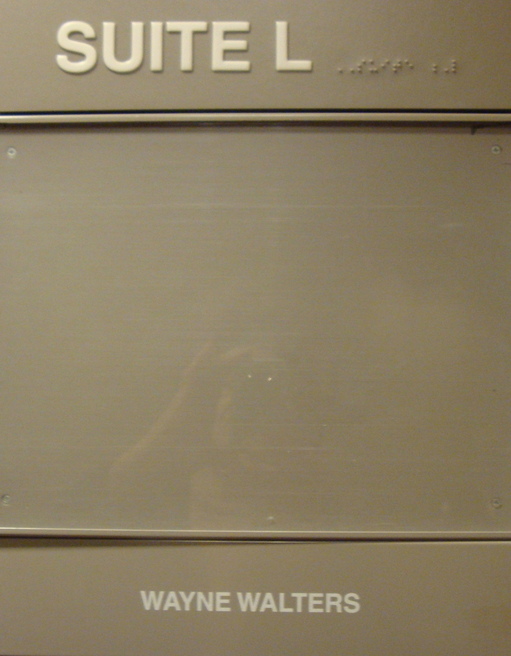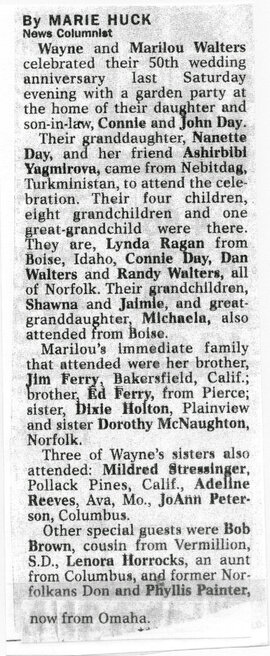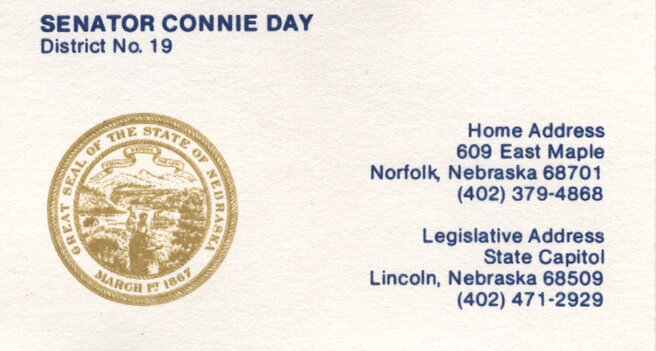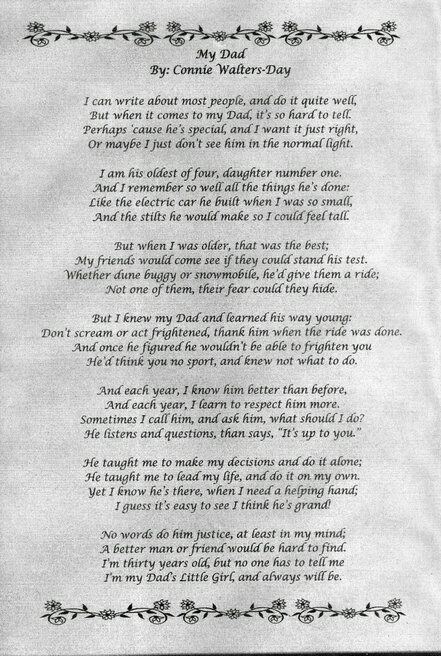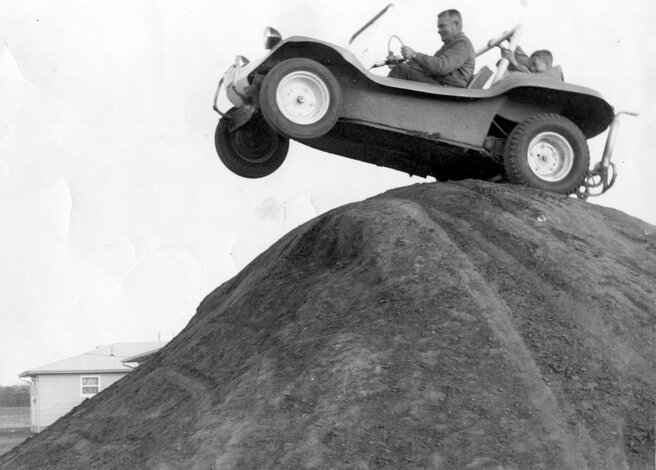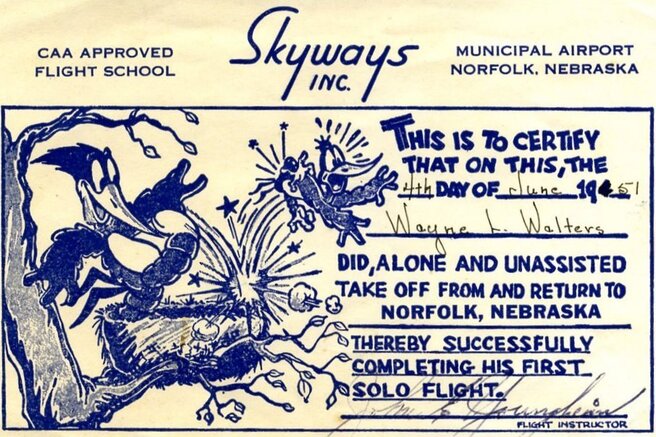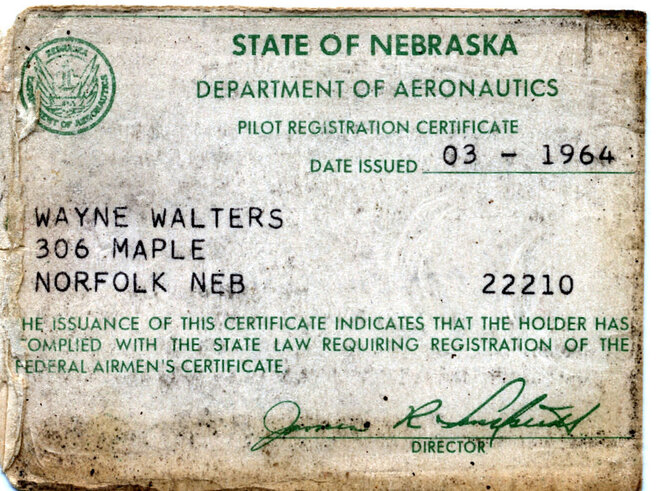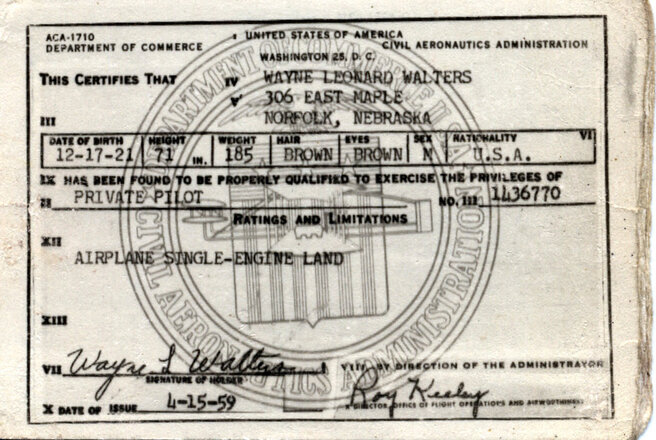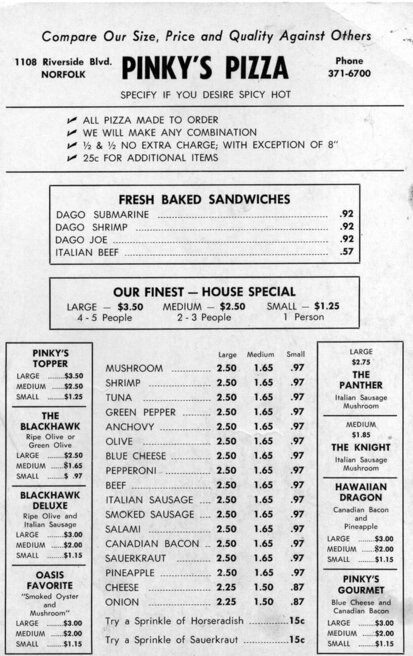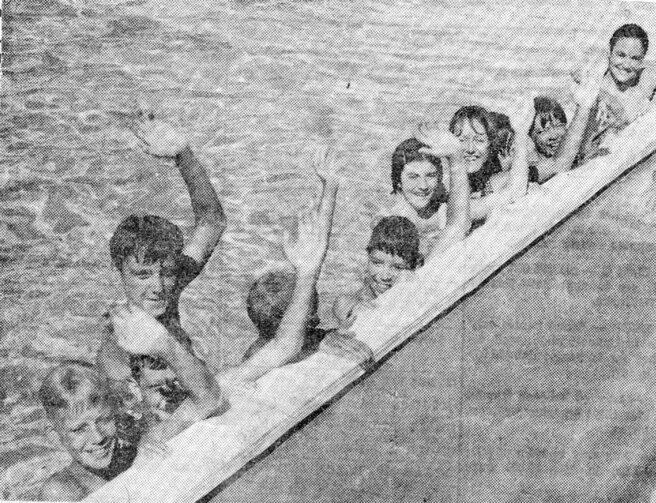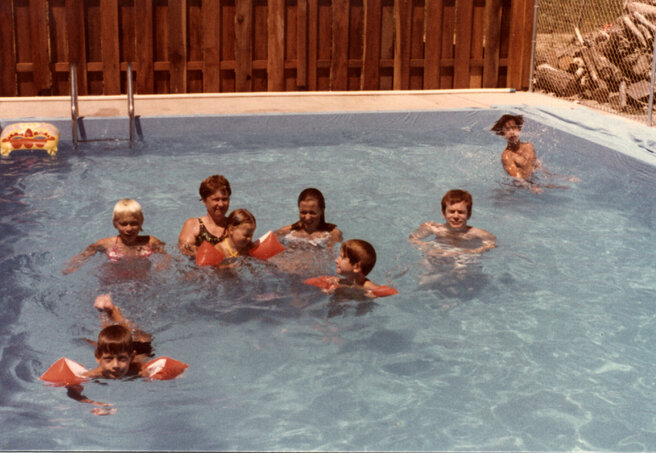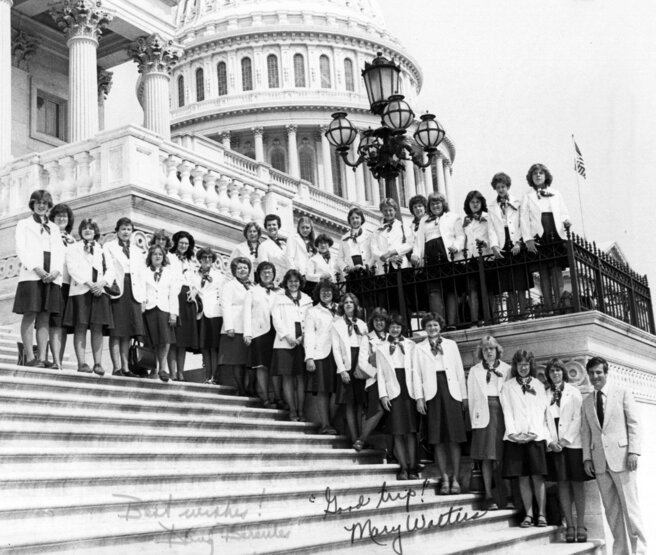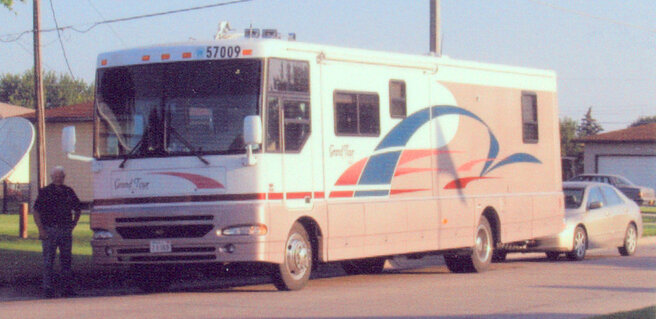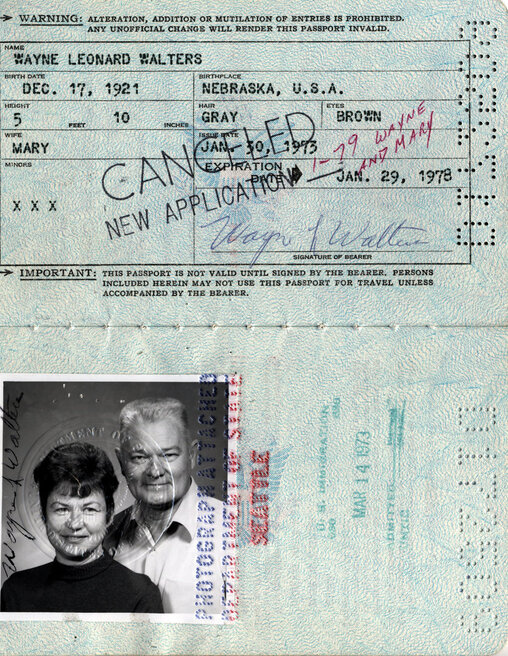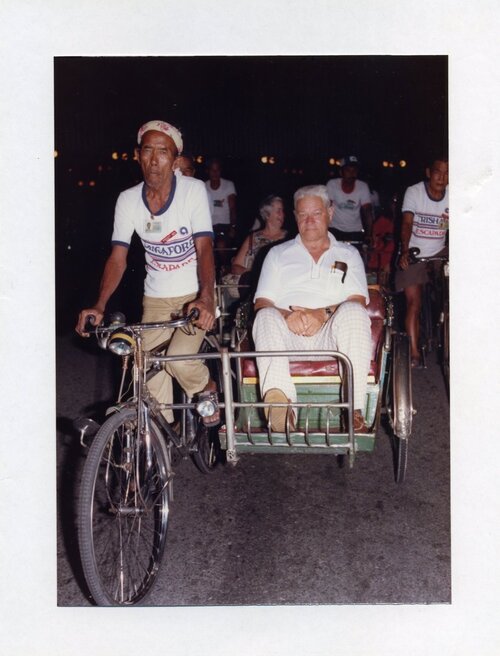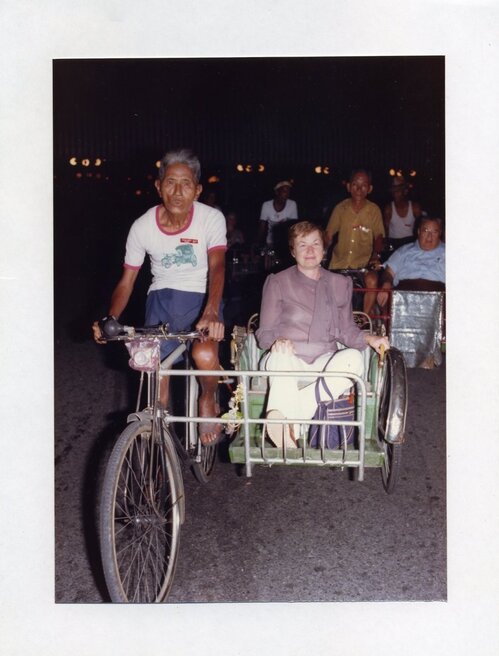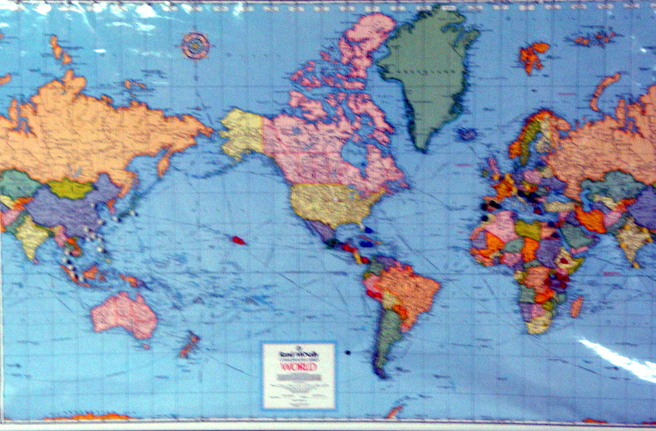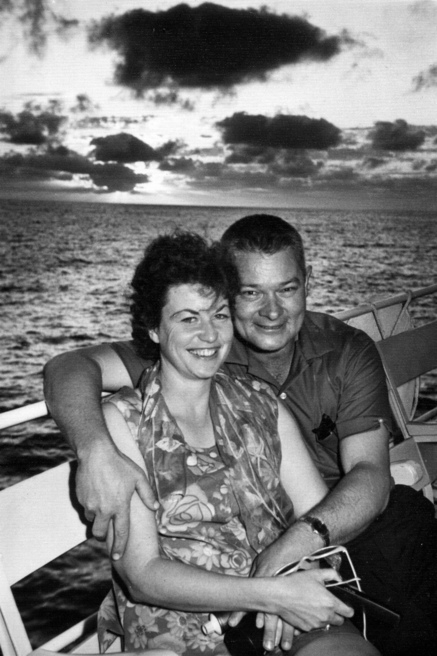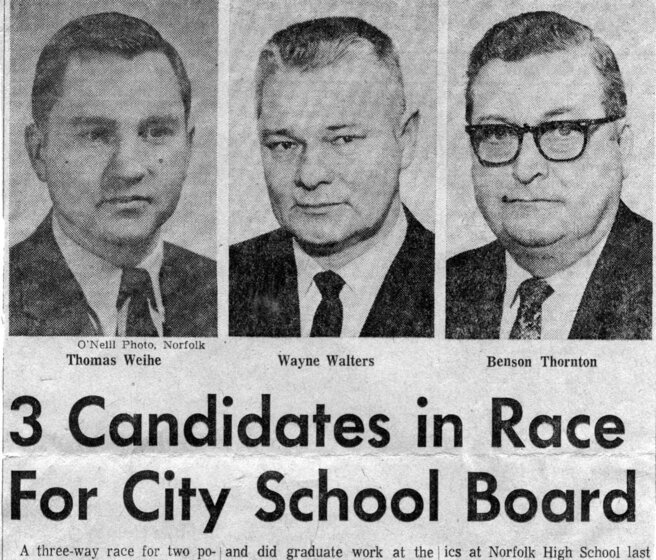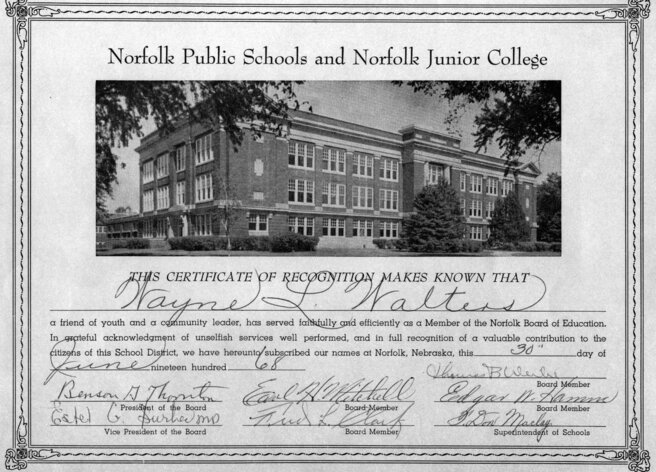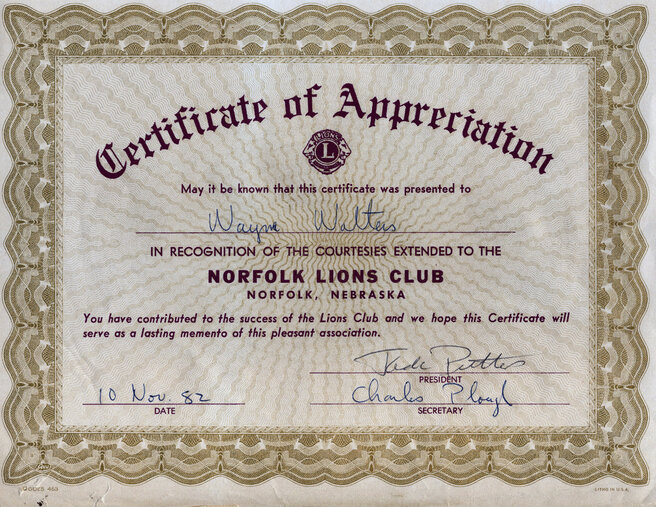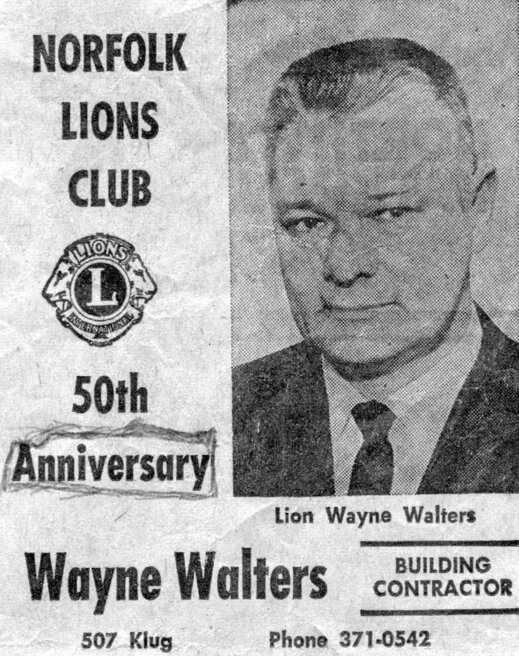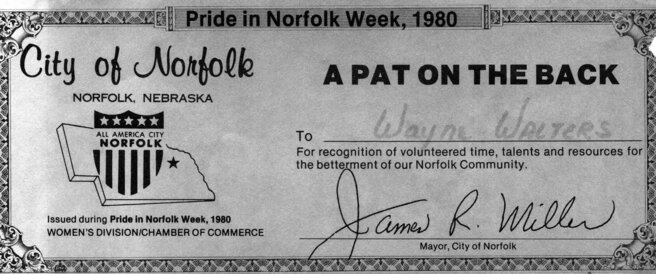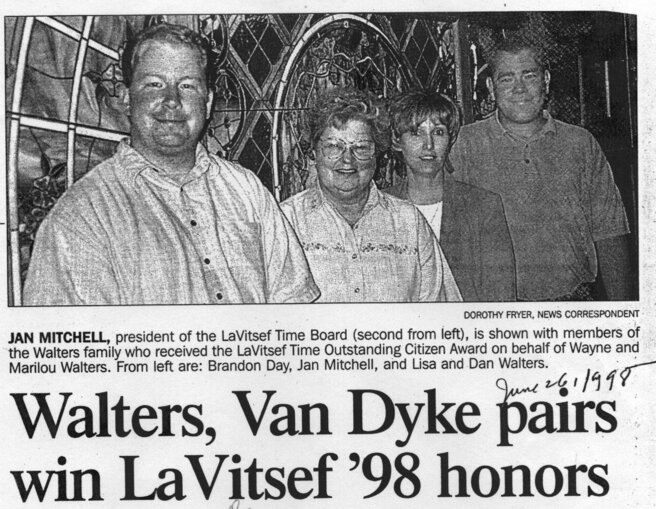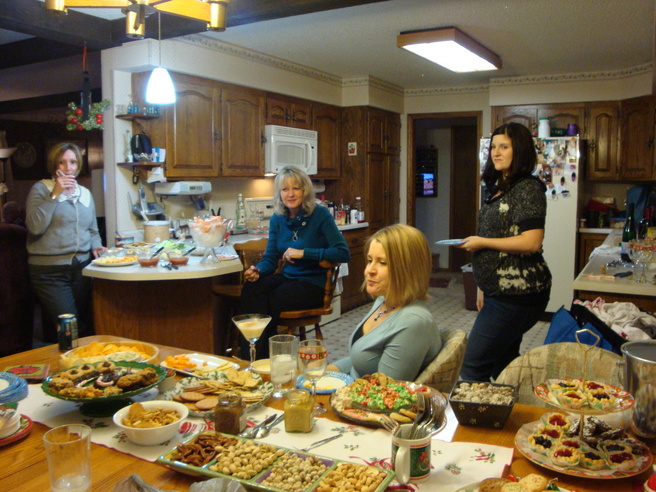PREFACE
This began as a biographical sketch of Wayne’s early life, and particularly his anecdotes of his War years as told to me, but his life covered so much more, including his family, that some flashbacks are called for to better round out Wayne’s life as he lived it and achieved his dreams.
Wayne and I had known each other for many years. Now that we were both single again, over dinner in December 2001 we discovered we had so much in common rekindling old memories. Our romance speeded up and on Valentine’s Day (February 14) 2002 we were married in Denver. Wayne’s urge to travel kept us on the road enjoying car trips and visiting family. We enjoyed eight years of wonderful married life before Wayne passed away.
Early Years: The Early Days
Wayne was born December 17, 1921, to Herman C. and Lena (Dittman) Walters, on a farm north of Tilden and Highway 275, Mills Township, in the southwest Corner of Pierce County, Nebraska. Wayne was baptized April 2, 1922 in the Evangelical Friedens (Peace) Church in Tilden. Although no Pierce County school or census records were found for the Walters family in the 1920s, Herman and Lena Walters leased this farm for several years after their marriage on May 11, 1920, in Tilden, NE. Herman Carl Walters was born February 21, 1896 in Clinton County, Iowa. Wayne’s mother was born November 25, 1898 in Düsseldorf, Germany, daughter of Theodore John Jacob Dittman and Marie Christina Boockhoff, and named Karolena Dorothea Helena, shortened by family to “Lena”.
Wayne was too young to remember that farm where he was born, and was not yet three years old when his little sister, Helen Louise, tragically drowned in the stock tank out by the barn. Helen Louise was born June 12, 1923, and only 1 year, 2 months and 17 days old when she fell into the water tank on August 29, 1924. Herman later explained to his brother Bill that he had been freezing ice cream out by the well and water tank that day, as Wayne and little Helen played there in the yard. While the ice cream was freezing he became occupied with repair of a harness in the barn and when he returned, little Helen was floating in the water tank. His efforts to revive her were unsuccessful and it was a terrible loss for all the family. The Tilden newspaper account of her death referred to the Herman Walters family as living six miles north of Tilden at that time, but the exact location of their farm was not given. Helen Louise was buried in the Dittman (grandparents) family plot in the Tilden Cemetery (Madison County section).
Wayne said his best memory of his early childhood was being crowded in with furniture in a horse-drawn wagon, and the long bumpy ride, as his parents moved from Pierce County to a farm about 2 1/2 miles south and 4 miles east of Elgin. The Antelope County 1930 Census shows the Herman Walters family in Cedar Township--the SE ¼ of Sec. 21-T23N-R6W-- and listed Herman C. 34 yr; Lena D. 31 yr; Wayne L. 8 yr; Mildred L. 5 yr; and Adeline F. 3 yr. Wayne’s sisters, Marian ( B 1934) and Jo Ann (B 1932), were also born on this Elgin farm and the family lived there until 1936, when Herman leased a better farm 1 1/2 miles south and ½ mile west of Oakdale, the SW ¼ Sec. 14, Oakdale Township. He bought this farm in 1947.
At Elgin Wayne and his sisters attended the Horn District 12 country school on Sec. 22, about 3/4 mile from their farm. Wayne completed the 8th grade here, but had to go to Elgin and take a test before he could officially graduate. This probably was in the Superintendent’s office, and Wayne remembers some of the schoolteachers: Ruth Wagner, Mrs. Hopkins and Agnes Limbaugh. Wayne then attended the rural Starr High School through the 9th grade. This school was located about two miles farther east, on the SE ¼ Section 23, as part of the Methodist Morningstar Church complex. The Church itself was on a hill on Section 24, east across the road from the school. The church building no longer exists, but the old wooden schoolhouse still stands, boarded up and slowly surrendering to time and the elements (Road 836). One of their early Elgin neighbors Wayne knew well was Dewey Carr.
FARM LIFE and SCHOOL DAYS
One day on this Elgin farm Herman surprised the family by bringing home a small Shetland pony—in the back seat of his Model A Ford. Addy thinks she was the first one to ride the pony because she was shorter and not so heavy—bareback of course, as all the family rode their horses without saddles. She wasn’t sure how well she rode or how she got off. Wayne rode “Tony” the ¾ mile up the hill to the grade school, but he was too tall for the pony. So they built a cart with steel wheels and Tony pulled Wayne and neighbor friend, J. G. Totten, up the hill to the Starr High School when they were in the 9th grade. There was a barn for horses as other kids also rode to school. (Totten later lived in Wichita). Sometime after, the pony was sold and came to a terrible death as the barn in which it was stabled caught fire, and it could not escape.
Wayne was born in the “Roaring Twenties” but grew up in the “Dirty Thirties”—the great Depression that changed many lives forever. The crops were mainly corn and oats, for which farmers felt lucky to get 10 cents a bushel. Often crops burned up in those hot, dry years as irrigation was virtually unknown, and much farmland in the mid-west became a giant “dustbowl” of blowing topsoil and sand. On the Walters farm all the family took turns at milking the cows, even Millie and Addy when old enough, and there was always a large garden, and chickens. Wayne must have eaten a lot of chicken as he no longer had much taste for it, no matter what kind of seasoning! In 1921 bread was 10 cents a loaf, gasoline $.26 a gallon, 2 cent stamps, and a car could be bought for $325. Prices were a bit higher in the 1930s, but there was also very high unemployment as the financial collapse filtered out from the east, closing factories and shops all over. Many a farmer had borrowed money in the good years, and then lost his farm as without crops he could not pay the mortgage. Wages of $1.00 per day, or weekly $3. to $5. was considered good if one could find such a job. A new way of life for many unemployed men was “riding the rails” from one soup kitchen or bread line to another, as those facilities sprang up all over the country. Railroad yards often became unwilling hosts to “hobo jungles” as the displaced banded together to share their wretchedness. Around campfires and makeshift shelters they listened eagerly to survival hints from old-timers on the rails, who sometimes revealed code marks leading to a free meal from some sympathetic housewife, or maybe a bit of ‘paid’ work. Norfolk Junction often had such transients whose marks on sidewalks led to houses on Omaha Avenue where a meal might be had.
The country was overrun with gophers, and when Wayne heard that Antelope county paid 10 cents per skinned gopher with the head left on as evidence, he trapped gophers. During corn picking time Wayne headed to the fields early in the morning and quickly picked as many ears of corn as he could, made a big pile, then headed off to school. As soon as school let out he hurried home to finish his corn picking job. His dad paid him one or two cents a bushel—it was a lot of work for a little money—but better than no money!
Sometime in 1936, probably March, the customary farm moving time, the Walters family settled in on the Oakdale farm—the SW 1/4 of Section 14-T24N-R6W, in Oakdale Township. They liked this place so well that on January 31, 1947, Herman bought the farm for $8,000. The Walters family lived there many years, until Herman retired from farming in the 1950s, leased the land to a neighbor, and moved to Norfolk. Herman and Lena then lived at 105 North Cottonwood Avenue, a house that son Wayne had built for them. On February 26, 1960, Herman sold this Oakdale farm for $16,000. to Joseph H. Grosserode, a neighbor who owned other land nearby; that name is still listed on local mailboxes.
The Oakdale High School—Wayne remembers it well. It was 1937 and he was in the 10th Grade, bored, and decided he’d had enough. He was more interested in working for pay than studying. The new Superintendent, Mr. John A. Schimonek, tried to talk him out of quitting school— “Wayne you will never amount to any more than just a ‘ditch digger’ if you don’t finish high school”. It’s ironic—–some of Wayne’s school friends did finish high school and several even went on to college, but Wayne and his ‘digging’—his successful construction business—have brought him greater financial success, and satisfaction, than any of those friends achieved, with all their education!
This Oakdale farm sits in an area of rugged country southwest of town, though none of the original buildings remain. Today enormous oak trees still cover the hills and the picturesque lowlands, where the Cedar Creek winds through. The Cedar Creek was a favorite fishing spot where Wayne often had good luck catching carp; at the nearby County “poor farm” he caught bullheads. In later years the rugged lands adjoining the Walters farm to the west, became part of the Tintern Abbey in Section 15 (Road 843). The Oakdale Cemetery lays between the road that runs south out of Oakdale and the Walters farm to the west, so the kids walking home from town often took a shortcut through the cemetery. The Strahm family farmed south
across the road from Walters and the old Strahm farmhouse is still standing. Wayne’s youngest sister, Marian, has written her memories of how thrilled she was when her folks brought home a piano one day, and she was able to take piano lessons from Strahm’s daughter, Anna. Sister Jo Ann also took piano lessons from Anna. The Walters girls walked a couple miles west of the farm to attend the District 119 Fairmont School, which no longer exists.
In the beginning, all farm work was done with horses and farm kids were taught how to properly hitch horses to farm equipment and wagons. Wayne quickly figured out that he could ride on the harrow instead of walking behind the horses, so as soon as they were over the hill out of dad’s sight, he hopped on for an easy ride. Addy said she felt safer just walking along behind when it was her turn. Everyone rode bareback—in fact, there may not have been any saddles—would have been too expensive. Wayne had been riding horses bareback all the time, so there couldn’t be anything special about riding a new work horse that had been used in rodeos—or so he thought. Finally, after several unsuccessful attempts to hang on to the high-strung, bucking horse, he gave it one more try. He tied it to a large, heavy hayrack frame in the farmyard, figuring to mount the horse from that higher point. The horse had other ideas, and tremendous strength to its advantage, and in seconds pulled the hayrack clear off its frame—no way was Wayne going to sit on its back. So the horse won that game, and Herman never did figure out how that heavy hayrack got separated from its frame.
It was a special event when Herman bought his first tractor in 1931 or 1932. After his demonstration to the family, everyone agreed that the Fordson would be much quicker and easier to plow the fields. But of course, they shook their heads—Wayne was still too young and short to drive that tractor. Ha—a challenge Wayne could not resist. When alone, he figured out that if he stood with his full weight on the clutch, then he could shift the gears, and that’s how he drove that tractor! He was only 10-11 years old at the time. In 1936, Herman bought a Model B John Deere tractor for about $200 and traded in 3 or 4 horses which were no longer needed for farm work (including that ‘rodeo horse’.) Farm work had become much easier and was done in less time. Both Wayne and Millie could drive the John Deere.
On the Oakdale farm they became well acquainted with their good neighbors, the Gottfried Strahm family, south across the road. The older Strahm boys bought wild horses from western Nebraska at the Norfolk Horse Sale barn, located on north Square Turn Boulevard. (Part of that old horse barn still stands today). They broke the horses at home and took them back to the sale barn to be sold. Unbroken wild horses weren’t worth much to anyone. So horses said to be ready for harness and sold that way, were hitched to a large heavy wagon and driven around the sale barn track to prove that they could be harnessed and would respond to commands. If not satisfactory, it was no sale. When the Strahm boys stopped in to say they were going to the sale barn to look at horses. Wayne often tagged along.
TO WORK
All through the 1930s, before World War II, jobs and money were scarce. Wayne never hesitated to take on difficult or “dirty” jobs. He picked corn for Art Rodekohr; then worked for the Voss Insulation Company out of Battle Creek insulating farmhouses; and handled asbestos insulation for a short time (a real NO NO! today). His Social Security card was issued February 2, 1940. By 1938 Wayne had saved enough money to buy his first car, a 1933 or ‘34 Ford, used but in good condition, and though it had the notorious “suicide doors” it’s speed and power were his pride and joy.
War clouds had been forming already in the late 1930s. December 7, 1941—that Sunday afternoon Wayne and his friends came out of the Neligh Moon Theater and listened in disbelief to the blare of his car radio—that the Japanese had bombed Pearl Harbor, Hawaii, at 7:53 A.M. that morning. Right away that’s all everyone talked about, and all knew it meant war. The Declaration of War on Japan was approved by Congress and announced by President Roosevelt the next day, December 8, 1941.
In the spring of 1942 Wayne was drafted through the Neligh office, but due to his poor teeth he was classed 4F and not accepted. He then worked odd jobs and saved enough money to pay the dental bill of Dr. Garrison at Oakdale, who extracted his decaying teeth and fitted him with dentures after he suffered without any teeth for 6 weeks—that was customary in those days for the healing process. Dentists did their own laboratory work, and his dentures fit perfectly. He wore those same dentures all his life and could eat anything! Unbelievable !
All across the country businesses and people were gearing up for the War in every way possible. One of Wayne’s more interesting and better paying jobs was working in the Mead, Nebraska Ordnance plant. This was 17,290 acres of choice farmland southeast of the small town of Mead, (south of Fremont) relinquished by the farmers thru Government edict, and then built into a huge complex of buildings to make bombs and explosives for the war effort. Wayne applied for work and was hired December 30, 1942, in the motor transportation and stores department, as a truck driver helper (1 ½ ton & over) to begin with, at a pay of .60 cents per hour. On February 8, 1943 his pay was increased to 75 cents per hour due to “extraordinary ability in handling 1 ½ ton semi–trailers”. Again, on April 5, 1943, his position was “Truck Driver 1 ½ T & over & HE” (heavy equipment), with pay increased to 80 cents per hour. (These rates may seem ridiculous by today’s standards, but back then a 40 hr week paying $32. or better was considered very good—many people were still working for $4. or $5. a week. BW)
Wayne felt himself lucky and quite well-off to have such a decent, good-paying job at last. Truck driving for the war effort appealed to him, and his driving record was without mishaps. He applied to work the night shift, where he could set his own pace. He loaded 10 or more of the 500-1000 lb. bombs filled with TNT or similar explosives onto his truck, and then drove his semi to one of the many secret and secure sites on the plant grounds where another crew unloaded the bombs. The bomb storage silos were scattered, and covered with dirt as camouflage. Learning about TNT and other explosives came with the job, and it was an eye opener and thrilling shock to newcomers the first time they helped dispose of leftover explosive scraps in an established burn area—the TNT did not explode but flared up into a tremendous flash of fire. Security in and around the plant was extensive requiring identity cards for admittance, and change of clothing for all regular workers due to the hazardous materials. However, in those days concern for worker health, etc., did not receive the priority it does today. Truck drivers were employed through established trucking companies, such as the Watson Trucking Company of Omaha. Wayne roomed at a boarding house in Fremont and drove back and forth to work. Housing was a tremendous problem and at a premium for everyone...so some people slept in shifts. The original buildings have been removed, except for a few old guardhouse huts and misc. towers, and the entire plant area is under EPA hazardous cleanup status.
See an interesting note about the old standpipe at the end of this book The history of the Mead Ordnance Plant is currently being researched and written by local Mead historians. Wayne and I drove to Mead and found only a few odd huts left, but it was a surprise to see the good cement roads still there, running through the middle of cornfields today, as some of the ground was later returned to farming. The National Guard and University of Nebraska today utilize most of the ground not farmed. Many “old timers” recall sledding down the old “standpipe hill” in winter and it would not be surprising if Wayne was one of those kids.
Wayne’s work at the Mead Ordnance plant came to an end May 15, 1943, with the notation on his card “reduction in force”. Other plants around the country were also accumulating stockpiles of war materials which may have lessened the pressure on the Mead plant, which formerly operated around the clock, 7 days a week. It was well understood that the “war work” was a Godsend for many people and brought the country out of the depression in many areas.
While working at Mead he still lived with his folks at Oakdale and drove home on weekends. He soon became well-known around town by the sound of his Ford—a dashing 1933 coupe with notorious “suicide doors”— the doors opened out toward the front. Wayne chuckled at how he had customized his Ford by fixing a lever under the dash with which he could disconnect the muffler whenever he drove through Oakdale or Meadow Grove. His arrival was announced with an ear shattering roar—there was no mistaking who was “dragging Main”. His future father-in-law gave orders to his daughter, Mary Lou Ferry, that she was not to ride in that vehicle under any circumstance! (What dad didn’t know---------!!)
It had been a good run for Wayne at Mead, and his job search led him to other war related work. At Sidney, Nebraska, he worked on the railroad being built there at the Sioux Ordnance Depot, by the Kiewit Condon Company (later Kiewit Construction of Omaha). For a short time his father also worked in Sidney, during the winter months after crops were harvested.
He shipped out on the USS U.S. Grant from San Francisco in January, 1945.The trip took about 30 days, and was calm enough, the ship stopping twice for supplies at New Guinea.Ship quarters were very tight and only two meals a day were provided.With such extremely short rations the men were always hungry.Wayne volunteered for ‘KP’ duty in the kitchen—just so he could get extra food to eat.“Extras” were hard to come by so an apple stashed in his pocket easily brought a dollar from another hungry serviceman.Time hung heavy on their hands after routine drills and chores, so gambling became an easy and natural way to pass the long hours at sea.Wayne joined the crowd, winning at craps, but losing at poker.In total, his tour of duty provided some gripping raw material for many anecdotes, some of which he later told with humor, but some were never told.(See note about the US Grant at the end of this story).
The 100-ship convoy landed at Leyte in the Philippines. At Manila they left the train which had brought them closer to the front lines in the north.There he joined his Division as a replacement.Getting enough to eat was still an issue, so at night men took turns foraging in the camp kitchens.Sometimes they were lucky and got gallons of fruit, but Wayne’s turn got him a can of peanut butter—but it didn’t go to waste.He was one of a 3-man automatic rifle
team and a bit unhappy when he was issued a sniper bolt action rifle (.03)—accurate but slow, and which he quickly discarded. As some of the men in battle went down, their better weapons were quickly retrieved and used by other infantrymen. Wayne later had a chance to get a heavy Browning automatic rifle, along with 2 assistants to carry the ammunition.
Wayne was in heavy active duty in the Philippines for about 7 months from February until August of 1945.According to official Luzon Battle accounts, by February of 1945 U. S. troops had largely defeated the Japanese in the south and pushed them out of Manila to the north end of Luzon Island. In late February and early March the 33rd Division had considerable success overrunning Japanese positions and thus encouraged, their commander Maj. General Perce Clarkson, proposed and General Swift, Corps I commander agreed, to order Wayne’s33rd Division, which had come up as replacement for the depleted and battle weary earlier Divisions, to push hard north toward Baguio. Baguio was the prewar summer capital and also the northeast headquarters of General Yamashita and his remaining Japanese forces in the Philippines. But the 33rd Division was then outnumbered two to one by the Japanese, and progress was slow along the road to Baguio due to strong pockets of resistance from the enemy dug into the mountains all around Baguio. Casualties were heavy on both sides. Wayne recalled vividly the time his Division was fighting on one side of a mountain at Baguio.The 130-man Division had dug their own foxholes and were under intense fire; men were ordered to not leave their foxholes at night,—anyone or anything moving would be shot.One of Wayne’s unpleasant memories—not far from his foxhole one man did crawl out in the darkness.He was shot and cried out for help.It was a long night for all those troops who bore the brunt of the fallen soldier’s death cries—“you shot me”.Obeying orders, no one, not even the medics,moved out of cover.Finally death brought silence.Wayne and an artillery observer in the foxhole next to him had earlier worked out a signal—they tied a cord to each other’s arm so that when one needed to wake the other, a pull on the line would do it…no betraying sound or risky movement.
The high ridge would be difficult to take, and the men knew they were “bait” when ordered to take the ridge at all costs, so movement was a slow crawl.Even the commanding officer couldn’t speed up their climb up the mountain.Out of 130 men in Wayne’s Division, at the end of this battle, Wayne was able to count only 27 men left.That made a lasting impression.Thousands of Japanese retreated farther into the mountains and dugpermanent caves, where some lived for years even after the war ended, before being discovered. Routinely no American officer wore insignia, as officers were the first ones shot.Later at camp inspection, Wayne recognized the inspecting officer as the one in the foxhole next to him on the mountain. The officer never said a word but a wink was his recognition to Wayne—he was the other man with the cord signal.
In a few of these front line battle areas not the best feelings developed toward the “black”-Negro soldiers—after some of those truck drivers would not deliver needed supplies to the men fighting in the front lines.They did not seem to have the same “win the war” spirit—they simply stopped their trucks and refused to get close to the fighting.So “white” soldiers had to leave their battle positions, go back, and drive supply trucks up to the front with the needed supplies.Later several black troops were heard bragging to Philippine women how they were special night troops in battle—the reality was that some never got close to the fighting if they could avoid it.White soldiers went to town in groups due to this friction which was not forgotten by a number of soldiers from the front lines.And there were later incidents when several “black” men were shot, prompting recall of all arms from the troops for a short time, as outside of the actual war zone heavy arms were not needed.
THE WAR YEARS - Drafted Again 1944-1946
Six months later he was drafted again and in less than another six months he was fighting in the front lines in the Philippines. Wayne’s World War II memories cover the range of good and bad—admiration of the brave soldiers following orders even when questionable; as well as disgust at times over shirking combatants, and laughs at the “goldbrickers”.
Wayne Leonard Walters was inducted into military service September 28, 1944, processed at Ft. Leavenworth, Kansas; then arrived Oct. 14, 1944, at Camp(Ft.) Hood, Texas, for basic training.After 3 months training as combat infantryman, Wayne was Private 1st Class in the U. S. Army, 33rd Division, 136th Infantry Regiment, Company G, Serial No. 37 752 997.His training included rifle, machine gun and mortar, and he certainly could handle his rifle as well as any man.But Wayne liked to tell the story that to speed up the marksman training session in bad weather, officers hastily classed all the men as “qualified”.Impossible! the commander said—pick out 10% to be “qualified”.Wayne was in that 10%. In addition to the weapons and anti-tank training, there were all kinds of field and survival training exercises.In Wayne’s booklet “I Am A Doughboy”, Generals give tribute to the value of the “foot soldiers”—the infantrymen—with an authoritative quote from George S. Patton, Jr.:“Never overlook the doughboy.A thousand years ago it was the foot soldiers who won and held territory, and it will be the same a thousand years from now.”
Following a short visit home for goodbyes to family, fiancé Mary Lou Ferry, and friends, he boarded a train to the west coast.This was not the Union Pacific troop train that became noted for its stopovers at North Platte during the war.Local women had formed a “canteen” there in a former Union Pacific terminal and met the trains to present gifts of food, and support to the servicemen en route to their destinations.(This North Platte “Canteen” story became a book written by Bob Greene and was made into a movie in later years.)
Early on, most trains had been commandeered by the government for military purposes.The heavy rail traffic had caused a switch of Wayne’s Company to another line heading west, probably the Burlington Northern, but this also gave him an extra day or two at home before shipping out.Within 6 months of basic training he went from being a carpenter, to being shot at in the front lines in the Philippine Islands.
After these battles on Luzon, Wayne became very sick. No medical transportation was available so he walked from the front lines, stepping over dead bodies along the way, to reach base camp, and was transported to the hospital.Doctors kept him in the hospital for 10 days diagnosed with malaria, but it turned out to be pneumonia. He recovered and returned to active duty as a combat infantryman.With all of Wayne’s front line battle experience he could have had the Purple Heart—while in the hospital in Manila with pneumonia when he was asked if he wanted a medal, he said he was not injured at the front.That didn’t matter.The officers were freely giving out Purple Hearts in the hospital to all who wanted one.Had he accepted the medal, he probably would have been discharged earlier.
Wayne’s cousin, Richard, son of Richard and Stella Walters, was also serving in the Army and was stationed north of Manila.So one day during a lull in the fighting Wayne hitchhiked on Army trucks and visited him at his base. It was at an outdoor movie near Clark Field in Manila that Wayne first heard about the bombing of Japan, and that the war was over.Pres. Truman signed the order July 31, 1945 to use the atomic bombs to save soldiers lives.The B-29 bomber Enola Gay, built at the Bellevue Martin plant, dropped the first atomic bomb—Little Boy—on Hiroshima on August 6th; and the Box Car B-29—Fat Man bomb fell on Nagasaki August 9th.Japan surrendered, unconditionally as demanded, on August 14, 1945.General Yamashita did not surrender his 50,000+ troops until after the end of hostilities August 15, 1945.
The War ended just in time, as Wayne learned that his Division was scheduled to be one of the first to go ashore in the planned military land invasion of Japan., code named Operation Downfall, planned by the Joint Chiefs of Staff and Gen. Mac Arthur and Adm. Chester Nimitz.Estimated total casualties in such an invasion were extremely high—about 90%.So the atomic bombs saved American soldiers.Demobilization couldn’t come soon enough for most servicemen.
JAPAN - WAR'S END
After the War ended in August, Wayne’s Division entered Japan at Kobe as part of the Army of Occupation. Kyota was an eye opener to the military as this was a city of religious temples, all of which by express order were not bombed. But what a surprise—–inspection by the soldiers found that these temples were actually armories, filled with weapons and bombs—safe storage for the Japanese under false pretenses.Traveling around the countryside on trains Wayne and a fellow soldier, the only two Americans, were cautious and alert, but had no problems with the Japanese. In fact, local Japanese farmers ignored totally the back and forth of sightseeing American servicemen. It was a completely different life from that which he had just so recently experienced fighting in the front lines in the Philippines. Wayne spent a total of one year and seven months in foreign service in the Philippines and Japan. Temporary barracks were the norm—one was a converted Nissan factory in Yokohama, Japan. In Tokyo Wayne quickly volunteered to drive in the motor pool. The transportation pool had many “perks”.Major Brown was part of the U. S. military liaison between our Government and the Japanese, and Wayne enjoyed immensely being his driver.Among humorous incidents of those days Waynerecalled, was his first introduction to the Major who, seeing Wayne was about to salute, quickly grabbed his hand and said “Hi, I’m Major Brown”—with never a salute.Major Brown was not overly impressed with military formalities.Wayne’s assignment was to drive the Major all over Tokyo, and regularly to the hospital where the Major would spend several days visiting his girlfriend.The Major came over at the end of the War and wasfriendly to all—a genuine “goldbricker”.
The Major’s jeep carried a large sign “U. S. Military Government” which gave Wayne freedom to go wherever he wanted without question, even while some top officers couldn’t commandeer a Jeep.The Major returned to the States at the end of his tour, and several times had offered Wayne a job on his large farm in Ohio, but Wayne never contacted him.Wayne then drove for Base Utilities, also an assignment with very little work but “benefits”, such as the omnipresent Jeep, which he again drove all over sightseeing.This outfit soon disbanded and he reported back to his superiors who wondered what he had been doing all that time —– “Military Transportation Orders” ——his indisputable answer.Wayne’s attitude was well seasoned from surviving the frontline battles, and he was in the driver’s seat.So when he was ordered to pick up new officers at the Tokyo airport—a Lieutenant and Captain, andthey ordered him to load their pile of luggage, he replied “HELL NO—load it yourselves”.Another time, at the airport an officer insisted on sitting in front with Wayne—Wayne’s blunt reply:“No—this Jeep doesn’t move until my assistant sits up here with me”.Wayne gave his serial No. and rank severaltimes upon request due to such incidents, but there was never a problem as his commanding officer had also been in the front lines—they were friends and those later “greenhorns” had no status.
That year spent in Japan went quickly and easily enough but Wayne was getting anxious to go home. A junior serviceman with a lot less “battle time” learned after a punch in the nose,not to brag how he was going home first, just because he was married and had children.That status earned more points on which discharge from service was based, compared tosingle men like Wayne, who actually had put in more time fighting in the front lines.That’s life!
Wayne kept in touch through letters back home, and in December of 1945, he wrote to sister Addy that he was sure ready and anxious to go home, and he wished she would send some film, and some candy or cookies .Later back home he gave his old camera to sister Marian who used it for a long time as she had become interested in photography.
He took many pictures of the countryside, their base camps in Japan, and some of the destruction of Hiroshima and Nagasakiafter the bombing, as well as the historic Japanese shrines which had secretly and safely harbored bombs and weapons during the war.
Wayne's Military Ribbons and Decorations
Wayne’s military ribbons and decorations include the Combat Infantryman Badge, Philippine Liberation Ribbon with one bronze star, Asiatic Pacific Campaign with two bronze stars, Good Conduct Medal, Army of Occupation Medal, and the World War II Victory Medal, plus 8th Army and 2nd Corp badges, and his ID--“dog tag”.A lapel button was issued and he was recommended for further military training, but he had had enough of military life—civilian life was more appealing.Some of his souvenirs were the many good photographs he had taken in Japan, along with a Japanese sword and wicked looking scimitar.Also included were two Japanese silk flags, one with his name and rank in bold black ink, and the other flag signed by men in the Service.A list of the names was compared to the list of Combat Infantryman Badge awards issued in 1945 by the Headquarters 136th Infantry, which included Wayne Walters. Although Wayne did not sign the flag, it turns out that at least five signatures on the flag are also names on that official list: Abram, Marotta, Robertson, Sullivan, Jr., and Tarter, which might indicate that those men were in Wayne’s 136th Infantry Regiment.Wayne’s civilian life became so busy he never attended any re-unions of his 136th Regiment nor had any contact over the years with any of the men with whom he served
WAR'S END - Home at Last
Back in civilian life some adjustments were not unexpected as the rest of the country was also trying to return to some semblance of a normal life.But things were looking up as factories returned to providing peacetime goods; housing needs created a whirlwind of construction activity, and returning servicemen were entitled to advantages in education and jobs in appreciation of their service to our country.
Wayne and Mary Lou Ferry were married October 18, 1946 in the Methodist Church, Meadow Grove, Nebraska.
Their early married life was supported by various jobs as Wayne tried first one and then another, looking for work he really could enjoy, as well as earning sufficient wages. On the verge of moving to California in search of better jobs in the late 1940s, Wayne checked the Norfolk employment office one more time.Mrs. Gendron French told him that Blakeman Beverage Company needed a route driver.He applied and was hired—what a relief to work out in the fresh air at his own pace again, which was not slow.He was tireless and enjoyed driving the routes in northeast Nebraska, quickly increasing the volume of soft drink sales by his friendly approach to customers, and won several awards.But eventually, he needed work more challenging and rewarding.
A Home of Their Own
Anxious to have a place of their own, they bought a small house and had it moved to 403 North Pine Street, where Wayne dug the basement by hand with a shovel.This got Wayne interested in home improvements and he quickly turned his energies toward residential construction. He borrowed $600 from his dad to get started and built a few rental units for income. Construction work in those days was not easy as most all of it was done by hand—with limited power tools and equipment. But he persisted, ignoring opinions voiced by almost everyone around, that he would be better off on a regular job that paid steady wages. He learned quickly the fundamental principles of good construction, and heeded helpful advice from experienced and reputable contractors. By April of 1951 he had built and completed for him and his family their first real home at 304 North Pine Street, featured as the 99th Home of the Week in the Norfolk Daily News. After that it was one house after another as he improved his construction and handcrafting skills and house plans. A key point in Wayne’s success in residential construction was buying land to develop himself, maintaining excellent financial standing and records, and keeping up to date with changing trends in housing.
Walters Homes
Though those first years were difficult and not especially profitable.Wayne persisted—his knack for “doing things his way” paid off handsomely within a few years.He continued to buy ground and develop it himself with carefully laid out housing plans and streets.As his reputation for reliability and quality construction grew he was asked to build houses in almost every real estate development in the city. In sum total of over 60 years of house building, he easily has 600 to 700 houses to his credit, as well as distinct subdivisions in which his sons Dan and Randy continue to build.Several times he took over financially and physically a housingproject begun by another contractor, who was no longer interested in, or unable to continue the development.Wayne Walters to the rescue.Walters Homes became so well-known over the years for quality that it was not unusual for repeat customers to call him asking him to build them another house, usually larger than the previous one, in his new development.Repeat customers and satisfied homeowners for all these years are the priceless legacy of the Walters Homes, whether built originally by Wayne himself, or his two sons Dan and Randall (Randy) who succeed him in the business since 1998.Wayne early on developed strong financial resources and purchasing power, and maintained good relations with his suppliers, employees and the people who bought his homes.
Sons Danny and Randall over the years learned the construction business from Wayne, their best role model,and in 1998 they purchased the Walters Homes business from Wayne, allowing him to plan new developments on land he purchased, while they handled construction.Wayne’s‘hands on’ support continued as it was by then second-nature to him.
Ambitiously,in the early 1990s Wayne decided to learn the new computer technology to make his bookkeeping and business records easier to handle.He bought his first computer from the Day Company and taught himself largely through trial and error the major ins and outs of computer usage.Undaunted by the computer complexities he signed on to the Quicken programs of accounting and check writing for the Walters Homes business, as well as personal family finances, and continued that for the rest of his life.In fact, he had a tremendous interest in technology and was forever checking out the latest gadgets on the market, from some new clock to better cameras, the latest recorders and sound and television systems.He was a “do it yourself”kind of person and prided himself on working out solutions to problems—life provided him with interesting challenges which he tackled with enthusiasm and confidence.
Norfolk Contractor Notes 50 Years
Family Time
It was about the time of Wayne’s 50th birthday, while having a cold one at the “O” (Oasis) on Riverside Blvd. with friends, that Wayne felt so good about life that he just had to say how satisfied and happy he was with the accomplishments of his life up to that time—that he had done all the things he had really wanted to do, on top of that he had a loving wife and a great family.Wayne was an optimist and believed life was worth living to the fullest.Wayne and Mary Lou attended the First United Methodist Church, and raised a fine family of four children in those years:
Daughter-- Connie JoAnn, born March 10,1949, died July 24, 2001
Daughter— Linda Marie, born July 17,1952
Son--Danny Wayne, born July 7, 1957
Son--Randall Scott, born May 8, 1959
Being the optimist that he was life was not all work and no play.The passing years of Wayne building houses and Mary raising the family were filled with a variety of activities and travel for both.In later years they both endured and survived serious medical problems, Mary with cancer, and Wayne with a heart attack and 5-bypass surgery in 1989.But their zest for life come what may set the tone, and they were unique role models for all the family.
It was in the early 1990s that daughter Connie and husband John Day, moved from Florida to Norfolk, and soon began their successful computer accounting /auditing business.What is little known is just how influential Wayne was in bringing them to Norfolk.Of course, they had visited often and were part of the traditional Walters Christmas family gathering.Conversations had ranged back and forth as to Norfolk for business and a home place, encouraged by Wayne as he pointed out the possibilities and advantages of a town the size of Norfolk.John Day was later instrumental in securing the construction of the Life Long Learning Center on the Northeast Technical Community College campus, and in appreciation and gratitude for Wayne bringing them to Norfolk, he honored Wayne by naming a room after him in the Center, ” Suite L-Wayne Walters”.
A wonderful evening garden party on a perfect Saturday, July 20, 1996 at the home of daughter and son in law Connie and John Day, was the setting to celebrate the Golden Wedding Anniversary of Wayne and Mary Lou Walters.Friends as well as family came from far and wide to celebrate their glorious 50th Anniversary.
Life was marching on for all the family notwithstanding some ups and downs.Daughter Connie Jo Day endured several bouts of cancer in the 1990s in the midst of her successful legislative term in the Nebraska State Legislature, District No. 19, which had brought so much satisfaction tocolleagues, and joy to all her family.Despite early termination of her legislative career, she was determined to use her remaining energies, and spirit which never failed, to establish the Connie Day Fund to help area children.She was a dedicated champion of worthwhile causes, and her work in the Legislature and throughout the Norfolk area is well documented and will not be forgotten. The Day Garden at Skyview Lake was dedicated June 29, 2001, “In appreciation to State Senator Connie Day from the citizens of Norfolk for her many civic and legislative contributions. ”Connie Jo Day died on July 24, 2001 in Norfolk, with family at her side.
Wayne's Challenge
AIR TIME
With all the house building construction in those early years—work that he really enjoyed doing, he still had other things he wanted to do besides ‘work’.
Flying—that was one goal he decided early on to master.His first Pilot Log, with his Oakdale address, has only one entry for Nov. 22, 1942, a Cub J3F65, with Andrew A.Risser as instructor.This apparently cemented his desire to learn to fly, but the war years intervened.Andy opened his Risser Flying Service on south 81 highway in 1928 and never stopped flying or giving lessons, until his death in October, 1966.He was inducted into the Nebraska Aviation Hall of Fame posthumously in 1997, and held several records and awards, having logged over 20,000hours in the air, and held commercial as well as instructor’s licenses.In fact, almost anything to do with an airplane, Andy could handle it.In the late 1930s Andy taught a government sponsored Civilian Pilot Training Program.
Although that first flight with Andy Risser was the stimulus for Wayne to learn to fly, it’s unknown why Wayne was influenced to take lessons from John E. Youngheim, a youngprofessional who flew Cessna airplanes.They did have the ‘war years’ association, and that may have contributed.
So in 1951 it was time.Flying was a release from daily decisions, but Wayne flew mainly just for the pleasure of it.He observed all FAA regulations, mastered the instruments, mechanics and principles of flight; overall had good instincts for directions.He never got lost. Wayne’s Pilot Logbook entries show: first flying lesson May 16, 1951 at the local Norfolk Airport (later Karl Stefan Memorial Airport) under John E. Youngheim, flight instructor; first flew a Cessna 140, later Cessna 172.Youngheim was a well known local pilot, became the first official Airport Authority manager, and his flight training school at the airport administration building was Skyways, Inc.Mrs. Youngheim was the office manager.Wayne’s Logbook shows flights May and June, good progress noted.He received a certificate from Skyways, Inc. that on June 4, 1951, he did alone and unassisted take off from and return to Norfolk.(This was a considerable accomplishment so early in his training.)He then flew around Northeast Nebraska—Norfolk, Wayne, Hartington, Creighton, Tilden and areas, in July and August---take off and landing noted, drew grades of 80-85%; Sept. through Dec. 1951 covered small field landing, stalls, slow flight, and flights to Omaha, Lincoln and Norfolk.
January, 1952 practice landing, and solo flights Norfolk to Hastings, Lincoln and return; slow flight stalls and misc. practice. Entries–1959--show Wayne flying a Cessna 172, which had become one of the most popular planes in civilian flying. He applied for and received his Pilot License Oct. 15, 1959, his log book showing 101.15 total time (hours) spent on all classes. He passed the examination the first time, while some of his flying buddies had to take the test several times to pass.
He received two Certificates: April 15, 1959, Certificate From the Civil Aeronautics Administration, to fly an airplane single engine,and land.March, 1964 the State of Nebraska, Dept of Aeronautics issued a Pilot Registration Cert. No. 22210 to Wayne Walters, 306 Maple Ave.,Norfolk, Nebraska.
Over the years Wayne flew around northeast Nebraska with family members along for the ride.Daughter Linda vividly recalls flying over a Meadow Grove farm where cousins lived, and Wayne purposely flying low enough so that she could drop a package through a small opening in the cabin floor, a “drop” which the cousins on the ground below eagerly awaited.This was a fun thing to do on a Sunday afternoon.Entries in his Logbook ended in 1962, and no doubt it was increasing family and construction responsibilities which limited the time for such activity.
KP Duty Again
For a short time during these very early years Wayne and Mary operated the Miniver Café on the northwest corner of Pine and East Norfolk Avenue—KP duty again as Wayne recalled it— he mainly washed dishes.
Many years later after Wayne had constructed the buildings on Riverside Boulevard, on land he purchased from the King family, he again for a short time had a substantial interest in “Pinky’s Pizza” at 1108 No. Riverside.Pinky’s was located in the north half of the building that housed the Oasis Bar after it moved to those better quarters from downtown.The Oasis had already become a popular “Happy Hour” hangout for its regulars, and the added attraction of delicious pizzas and hot sandwiches right next door was irresistible.At that time Elmer and Alice Fuchtman operated the Oasis and often featured local musical talent, such as Dick and Bob Allison and friends, who entertained there regularly.
It was definitely a “go” but hiring and maintaining reliable staff to operate Pinky’s Pizza proved to be the problem that brought about its closure, to everyone’s regret.National pizza franchises had not yet become established, so this Pinky’s Pizza Parlor would have been a first and thus captured the local market.Wayne knew it was a lost opportunity when he could not persuade his friend to don that “hat”.
FUN TIMES
Wayne built his first swimming pool for the family at 306 East Maple Avenue in 1958, and thereafter a pool was always an important and much used part of the Walters backyard.In addition to their own family use, Mary devoted countless hours teaching and helping children, particularly the “physically challenged”, learn to swim in their pool.Wayne also built pools for friends, and continued to build houses all over the city.
Mary busied herself with raising the family, and developing her own interests.She was active for many years in the local Girl Scouts, and was instrumental in securing several bus trips to Washington, D. C. for the Girl Scouts.Later she took up the cause of the Campfire Girls.Mary was a lifetime member of the Jefferson School PTA.
TRAVEL
With house construction well established, winter vacations were in order for Wayne and Mary, before the onset of spring construction season just around the corner.Wayne loved to drive so they were on the go seeing the country and visiting families.The Walters family took up camping and boating, a good deal of which centered at Weigand Marina and the park along the Nebraska shore of Lewis & Clark Lake, on the Missouri River west of Gavins Point Dam.Soon it went from tents to campers and finally grand motor homes.Their last was a magnificent Winnebago in which to enjoy summer camping highlights --the annual Winnebago Camping Club Convention at Forest City, Iowa, was a “must do”.Mary even kept the books for their camping group.Camping was a natural door opener for the whole family and all the states and Canada were on their camping and fishing itineraries.
As CB radios became popular naturally every car and camper had to be so equipped.Wayne’s lifetime FCC Permit #17H3363 was issued Jan. 23, 1959.Next came portable TVs, and police monitors—a must have so a listener could boast about being the “first to know” what really happened...such as when the Walters home monitor gave them the inside track to a spectacular incident (or was it a plane accident?) in their part of town.After a good laugh by Walters “in the know”, the real story was never told.In winter camping was replaced by snowmobiling, providing an exciting round of winter fun and cross-country treks where ordinary motor vehicles dared not go.A guest rider’s sense of humor was put to the test after being ejected into a snow bank on a fast curve, but was recovered after hasty backtracking, and in the moonlight all had a good laugh.
Throughout their busy life they made time for extensive and fascinating travels abroad, flying to most major continents:Africa, Alaska, Australia, New Zealand, South & Central America, Europe and England, Canada, China, Japan, Malaysia, India, Caribbean Islands, and of course, all 50 United States.They brought back some wonderful artworks and sculptures as their souvenirs.
Wayne invested in good cameras,recording equipment, and projectors,and they never tired of showing their magnificent travel slides to family and friends, including at school and special events.Some of their favorite trips included the Taj Mahal in India, Machu Picchu in Peru, the Great Wall of China, the Pyramids of Egypt and their African safari.His one regret was never traveling up the Amazon River in South America.
A REWARDING CIVIC LIFE
Although Wayne’s “Quality Homes” became his life’s ambition, providing him with continuous though flexible work schedules, he became very interested in civic matters and served competently on the Norfolk Planning Commission, Norfolk Public School Board, the Lions Club, Elks Lodge, and Norfolk Area Homebuilders Association.He was also a member of the Building Construction Advisory Committee of the Northeast Technical Community College.Wayne had a lifetime membership in the Veterans of Foreign Wars (is listed on their wall here) and held membership in the American Legion.Both Wayne and Mary over the years received many well deserved accolades and awards from the organizations they supported.Their interest and dedication were greatly appreciated.In 1998 they received the Outstanding Citizens award at the LaVitsef Time program.
As Wayne devoted more time to construction plans for new additions, Mary was able to pursue more of her own interests and hobbies.Already one of her greatest joys was making every Christmastime a truly meaningful and enjoyable celebration for all the family.
Delighted with the narrative of Christmas Past, ceramic gifts to her of historic buildings and figures portraying life of that fictional time, were the ideal starter for her to begin her own construction of the Dickens Village.Thereafter, she devoted her time, energies and resources to building more Village scenes and activities, quaintly depicting earlier times in an old English world, and merging for young and old the Christmas Past with the Present.Of course, Wayne had to construct adequate foundations to support the Dickens Village (which was beginning to compete with his own construction, it seemed !) Christmas was never quite the same after that as the tradition of Dickens Village came alive on Christmas Eve. Here are a few pictures of the way it was back then. (See more photos in the gallery).


